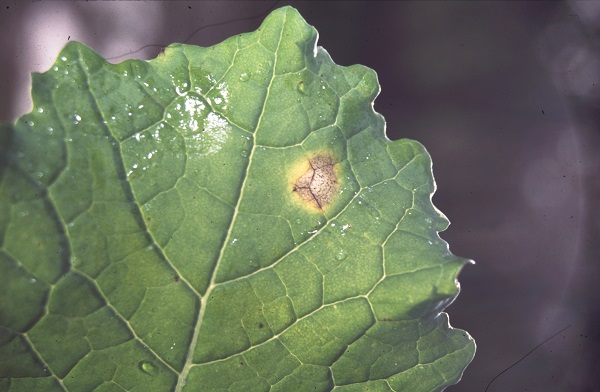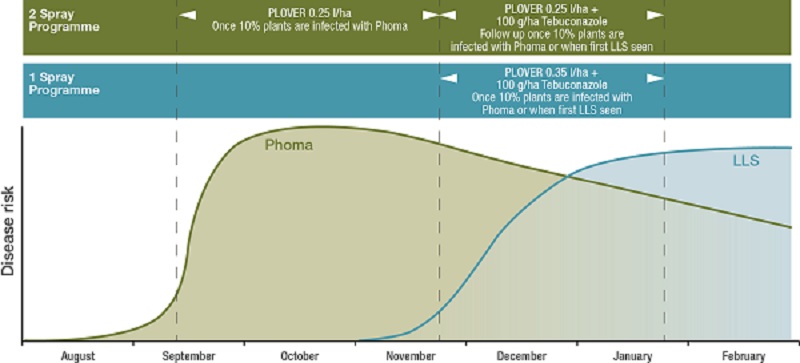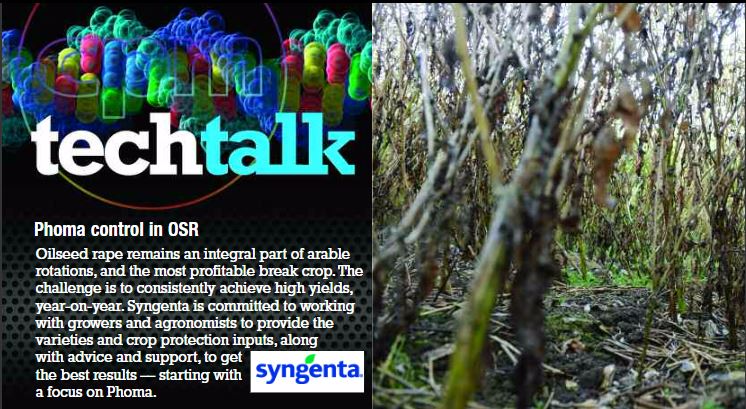Putting the pieces of the autumn disease control jigsaw together provides the basis for a joined-up approach to managing phoma. CPM gleans some expert advice.
Phoma has the potential to be an economically devastating disease.
By Lucy de la Pasture
Phoma is one of those diseases that you can’t be complacent about, because when it strikes it can decimate yields. In recent years, light leaf spot has been hogging the headlines but phoma hasn’t gone away and still poses a significant threat to the productivity of UK oilseed rape crops, especially where susceptible varieties are sown.
A good understanding of the pathogen’s lifecycle is critical to help growers safeguard their OSR crops believes Prof Jon West, senior researcher in plant pathology at Rothamsted Research. But if genning up on epidemiology doesn’t appeal, the smartphone app, Croprotect has all you need to know about its lifecycle and control just a fingers touch away.
What is phoma?
Phoma is a disease caused by fungal pathogens, Leptosphaeria maculans and L. biglobosa. Leptosphaeria sp. survive over summer on crop debris, particularly the taproot and stem bases of old OSR stubble, and in the autumn they produce fruiting bodies which release airborne ascospores. These then blow into nearby OSR crops and although they can blow long distances, most are deposited within 300m of the source.

Jon West reckons a good understanding of the pathogen’s lifecycle is critical to help growers safeguard their OSR crops.
Ascospores will germinate overnight in moist conditions and infect leaves via stomata and wounds. Symptoms of infection are small pale lesions (phoma leaf spot) that appear 7-15 days after infection, depending on temperature. The pale lesions develop black specks (picnidia), which are additional asexual fruiting bodies. These release further spores which are spread to other leaves by rainsplash.
The fungus grows within the leaf without symptoms and spreads to the stem, where it incubates until early spring. Rapid growth by the fungus then produces a visible stem rot or canker.
What impact does it have?
Phoma stem canker is a disease of worldwide importance in OSR, resulting in losses amounting to more than £500M per season through severe epidemics in Europe, North America and Australia. In the UK, AHDB estimates losses in 2010 were in the region of £80M, so phoma has the potential to be an economically devastating disease.
Historically in the UK, phoma has been more important in southern England, with light leaf spot the most significant disease north of Lincs, but in recent years the balance has changed with LLS becoming prevalent in many regions.
Phoma can cause lodging and yield losses of up to 50% in crops, so remains a disease to be reckoned with. Severe cankers can disrupt water uptake, especially in hot conditions, leading to early senescence of crops and a consequent reduction in yield. Under UK conditions, cankers don’t reduce yield unless they expand to girdle at least half the stem by late May.
How important is pathogen type?
Lesions of L. biglobosa on leaves are usually smaller and darker in appearance than those produced by L. maculans, but both types vary

Small pale lesions appear 7-15 days after infection and develop black specks (picnidia), which are additional asexual fruiting bodies.
according to interactions with the cultivar and recent weather, so it’s difficult to identify speciation using disease symptoms.
Of the two Leptosphaeria pathogens, L. maculans is thought to be more aggressive than L. biglobosa but recent work by the University of Hertfordshire has shown substantial yield losses caused by the less aggressive L. biglobosa. It’s thought this may be because the resistance genes in OSR varieties to phoma may not be as effective against one pathogen type as the other.
How do you assess risk?
Whether a crop is at risk from phoma infections depends not only on region and dominant disease in the location the OSR crop is growing in – last year’s epidemic fuels this year’s – but also very much on the weather.
In 2016, a cold spring has been followed by a predominantly dry summer in the south of the country, in contrast to the North and West which has had periods of wetter conditions than average.
That means in southern regions, there’ll most likely be a delay in the maturation of fruiting bodies, so spore release will be late. In other regions, conditions have been more favourable for the pathogen’s lifecycle so spore release will be much earlier in the autumn.
There are useful online tools to help growers assess risk and time fungicide applications, such as Rothamsted’s phoma leaf spot forecast. This uses a weather-based model to predict when phoma leaf spots will appear and is usually updated for the new season around 1 Oct.
How does variety choice help?
Variety choice has a major influence on phoma development and is a good foundation for a control strategy. Plant breeders have around a dozen major RLm (Resistance to Laeptosphaeria maculans) genes to phoma stem canker to play with. A plant with resistance genes is able to recognise when a pathogen is trying to infect it and it then mobilises its defences to ward it off.
While almost all the major genes have been relatively rapidly overcome by the constant mutation of the pathogen, RLm 7 has proved remarkably robust despite its widespread commercial use across Europe.
As well as resistance genes, breeders also utilise a phenomenon known as background (or quantitative) resistance. Varieties with background resistance still can get the disease but it’s less severe and this is generally thought to be the more durable form of resistance in the longer term.
Quartz, for example, which tops the AHDB Cereals and Oilseeds Recommended List ratings for stem canker with a score of 9, has a combination of major gene and background resistance. Currently there are several other OSR varieties available on the RL also carrying good resistance to phoma with scores of 8.
What’s an effective control strategy?
Fungicides have very little effect once the fungus has reached the stem, so the best timing for fungicides is after the first significant release of ascospores in the autumn, ideally before more than 10-20% of plants have phoma leaf spots.
On susceptible varieties, a two-spray autumn fungicide regime is advisable if phoma leaf spotting occurs early in the autumn (before mid-Oct), while a single autumn spray is effective if phoma leaf spotting is late (appearing after mid-Oct).
On more resistant varieties, phoma fungicide applications can be more flexible in timing and reduced or omitted completely if phoma leaf spotting is late.

Triazoles still provide effective control, but rates need to be kept robust at 50% or more of the recommended dose.
Source: Syngenta
How does this tie in with light leaf spot?
Phoma has decreased in importance over the past 10 years, partly because breeders have improved resistance. But another contributory factor was a succession of relatively severe winters a few years ago, which delayed the stem canker development stage, thereby reducing inoculum in subsequent seasons.
As a result, phoma sprays are tending to go on later than they used to, which may be one of the reasons that LLS is increasing in prevalence. In other words, growers were previously inadvertently controlling light leaf spot when they applied phoma sprays earlier in the season than current practice.
How can we improve control?
It’s important to get OSR established well and growing away in the autumn to avoid having backward crops, which are more susceptible to phoma. If crops are on the small side, the risk of canopy effects has to be taken into account when selecting which triazole fungicide to use in the autumn.
Triazoles still provide effective control, according to AHDB work, but rates need to be kept robust at 50% or more of the recommended dose. New SDHI fungicides also give good control of phoma and an alternative mode of action.

It’s important to get OSR established well and growing away in the autumn to avoid having backward crops, which are more susceptible to phoma.
Source: Syngenta
Phoma priority for autumn disease control
Phoma is still the primary target of the autumn disease-control programme for Herts grower, Joe Cole. But he’s found that agronomy changes instigated to tackle the increasing challenges of cabbage stem flea beetle have helped in control of this primary autumn disease.
Earlier sowing and a move to growing only hybrid varieties for the past six years has improved autumn establishment of stronger plants with bigger leaves, which gives greater flexibility for the phoma-specific fungicide timings.
Oilseed rape in the 830ha of arable cropping farmed by Ben and Joe Cole, based at Russells Farm, Kimpton, and on contract farms on the Beds/Herts borders, is sown into a Sumo Trio cultivated seedbed, rolled before and after drilling to conserve moisture. The crop is given 30kgN/ha in the seedbed to get it going, then topped up with a bio-micronutrient foliar spray in the autumn to keep it moving.
In most seasons, he’d look to make a specific phoma treatment as soon as infection begins to take hold. “It’s important to get the timing right, which would normally be as a specific pass for the phoma,” he advocates.
Timing is typically determined by his agronomist, based on infection levels in surrounding crops and treatment thresholds. “However, last year, the weather conditions prevented the early application and we ended up combining the phoma treatment with a propyzamide herbicide application,” adds Joe Cole.
He reports that the single application of Plover (difenoconazole) last year was sufficient to clean up the crop and effectively protected it for the rest of the autumn. But if treatment was earlier and reinfection occurred, a second application would be required. At the later timing, he’d potentially look to bolster LLS control, if it was considered to be a threat, by adding tebuconazole to the tank mix.
Phoma resistance is considered as part of the variety selection process. “However, we know that we can manage any infection effectively, so the main driver is the autumn vigour and establishment, along with overall yield potential,” he says. “Having a crop to manage is the primary objective, and then we can look at the agronomy options.”
Last season variety choice was dictated by the availability of neonicotinoid seed treatment. But Joe Cole notes that even varieties with a phoma rating of 8 and claimed double resistance showed noticeably more infection, and that it came in earlier. The varieties selected this season have lower stem canker ratings, of 7 and just 5.
“In reality, the phoma resistance score makes little difference to the practical management of the crop as a whole, which will all be sprayed at the same time. But we’d prioritise more susceptible varieties, or crops with smaller leaves – potentially from later drilling or CSFB damage – to prevent phoma spread,” he says. In some seasons a more susceptible variety may require an additional spray if reinfection continued longer into the autumn.
With the extra autumn growth and the crop vigour from early drilling, Joe Cole highlights a spring PGR is increasingly important, and the fungicide effects that offers will also help to target any LLS infection. “Ideally, after the effective autumn phoma treatments, we can avoid a specific early spring fungicide and the crop will stay clean through to the PGR and flowering spray treatments.”
Phoma control in OSR: top tips
- Look for varietal resistance – those with a good score for phoma should be the first line of defence and also buy you flexibility with fungicide timings.
- Sow early to establish a vigorous crop – this will reduce susceptibility to phoma infection.
- Use phoma forecasts – along with crop scouting, these will help you fine tune the application of the first fungicide spray.
Phoma Alert
Phoma should always be the first priority for autumn disease control in oilseed rape, targeted early to prevent the worst effects of stem canker yield loss.
NEW for the 2016 season, Syngenta Phoma Alert will give advance warning of specific phoma risks for your crops, to help better timing of Plover applications. Working with ADAS, Phoma Alert will utilise reference crops, varietal resistance and weather forecast data to provide regular in-season updates of Phoma threats.
Plover provides the most cost effective and reliable treatment to stop development of Phoma leaf lesions and to protect plants from infection.
Crops should be treated at infection threshold, with applications prior to the end of November using Plover alone; for later or follow-up applications, Plover should be tank-mixed with tebuconazole where Light Leaf Spot is evident too.
Visit the Syngenta website to register for your local risk assessment for agronomy actions: www.syngenta.co.uk




